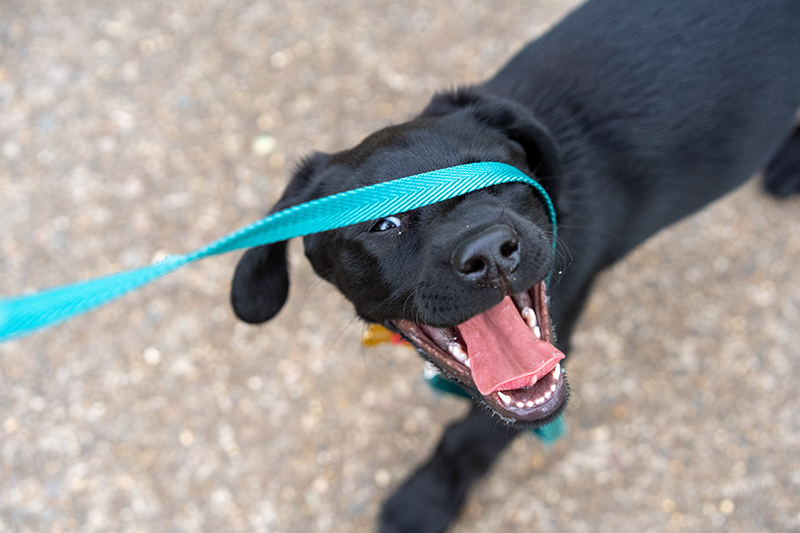Teaching Your Puppy to Master Leash Walking

Leash walking is an essential skill for your furry friend’s safety and enjoyment during outdoor adventures. At Posh Paws Pet Care, we are passionate about helping you become the best puppy parent and teaching your adorable companion the art of leash walking with confidence and joy. Let’s dive into the details!
Introducing the Collar or Harness and Leash
Before taking your puppy on a leash walking journey, it’s really important to help them become comfortable with their gear. Start by introducing them to the collar or harness and leash in a positive and encouraging manner. Allow them to sniff and explore the gear, rewarding them with treats and praises to create a positive association.
Once your puppy is at ease with the gear, gently fasten the collar or harness around their neck, ensuring a snug yet comfortable fit. You should be able to fit two fingers under the collar. Attach the leash and let them roam freely indoors for a short while to get used to the sensation of being on a leash.
Teaching the Cue for Leash Walking
A well-established cue is the key to a successful leash walking experience. Choose a fun and consistent cue phrase, such as “Let’s go for a walk!” or “Adventure time, buddy!” We have always used “Want to go for a walk?” Use an upbeat and enthusiastic tone when delivering the cue, making it a cue your pup can’t resist.
Consistency is key here. Always use the same cue phrase before each walk. Soon, your puppy will associate the cue with the exciting prospect of exploring the great outdoors with their favorite human. Even if you’re not their favorite human, they’ll like you for walking them.
Making Your Pup Come to You
Having your puppy come to you when it’s time for a walk is an essential part of leash walking etiquette. Practice this inside your home to create a strong foundation for outdoor adventures.
Start indoors in a quiet and familiar space. Use the cue you’ve taught them and call their name. When your puppy comes to you, reward them generously with treats and affection. This positive reinforcement will help them understand that coming to you means good things happen. Don’t abuse this cue. If you do, they will figure it out and become suspicious.
Indoors Practice for Leash Walking
Start by remembering to be patient with your furry little friend. Indoor practice sessions allow your puppy to focus on learning without the distractions of the outside world. Begin by attaching the leash and taking a few steps forward. If your pup follows along without pulling, reward them and offer praise.
If they pull or try to go in a different direction, stop moving and wait for them to return to your side. Once they do, reward them and continue walking. This consistent training will teach them that walking calmly by your side is the way to go.
Embracing the Great Outdoors

As your puppy gains confidence in their indoor skills, it’s time to venture outside. Start with short walks in familiar surroundings, gradually increasing the distance as your pup becomes more comfortable. During hot summer months, keep walks short and stay off of very hot asphalt.
During your outdoor walks, reinforce the cue for leash walking. Encourage them along the way with treats and kind words. Be patient if they get distracted; exploring new smells and sights is all part of the fun learning process for them.
Handling Pulling Behavior
If your puppy pulls on the leash during walks, it’s essential to address this behavior with positive reinforcement techniques. Avoid yanking back on the leash, as this may lead to more pulling.
Instead, stop walking when your puppy pulls and stand still until they relax and come back to your side. Reward them for walking calmly beside you, reinforcing the desired behavior. Teaching leash walking is a lesson in patience for you both.
Addressing Leash Lunging
Leash lunging can be challenging to handle, but with consistent training, you can overcome this behavior. Dog experts often label dogs who lunge and bark during walks as “leash reactive.” Your dog might lunge because they are excited to approach a person, dog, or object. However, because the leash is preventing that, they become frustrated and lose emotional control. When your puppy lunges, stand firm and redirect their attention with a treat or toy.
Reward them for walking calmly, teaching them that lunging doesn’t get them what they want, but walking nicely by your side does.
If you know your puppy will become a big dog, addressing this behavior sooner rather than later will be best for everyone.
Dealing with Leash Barking
If your pup tends to bark while on the leash, remember to stay calm and avoid shouting. Instead, distract them with a treat or toy, and praise them when they stop barking.
With time and patience, your puppy will learn that quiet walks are more enjoyable for both of you (not to mention your neighbors).
Conclusion

At Posh Paws Pet Care, we believe that leash walking should be an enjoyable and rewarding experience for both you and your puppy. By introducing the gear with positivity, teaching a consistent cue, and practicing in different environments, you’ll pave the way for successful leash walks.
Remember, patience, positive reinforcement, and love are the keys to building a strong bond and mastering leash walking together. So, gear up, cue up, and let the adventures begin.
